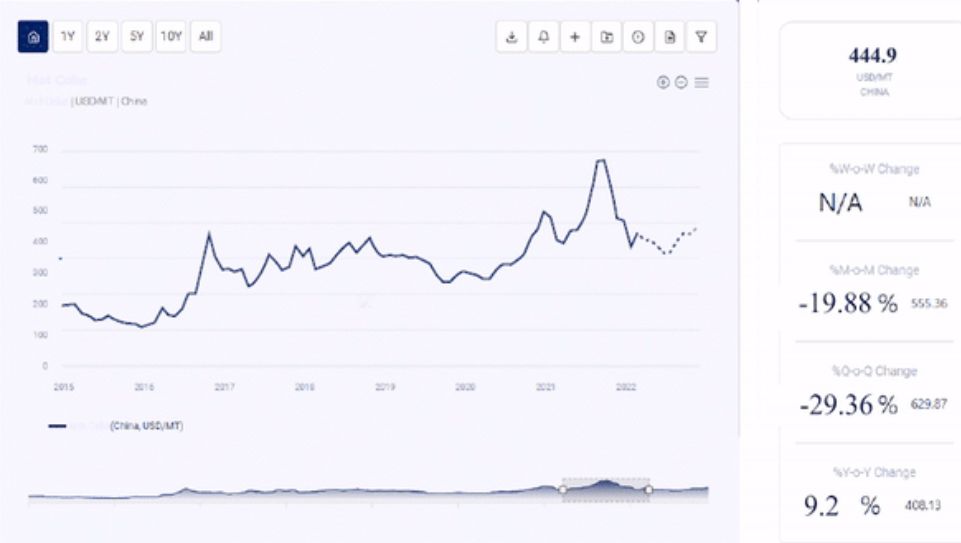| Report Features | Details |
| Product Name | Soybean Oil |
| Region/Countries Covered | Asia Pacific: China, India, Indonesia, Pakistan, Bangladesh, Japan, Philippines, Vietnam, Iran, Thailand, South Korea, Iraq, Saudi Arabia, Malaysia, Nepal, Taiwan, Sri Lanka, UAE, Israel, Hongkong, Singapore, Oman, Kuwait, Qatar, Australia, and New Zealand Europe: Germany, France, United Kingdom, Italy, Spain, Russia, Turkey, Netherlands, Poland, Sweden, Belgium, Austria, Ireland Switzerland, Norway, Denmark, Romania, Finland, Czech Republic, Portugal and Greece North America: United States and Canada Latin America: Brazil, Mexico, Argentina, Columbia, Chile, Ecuador, and Peru Africa: South Africa, Nigeria, Egypt, Algeria, Morocco |
| Currency | US$ (Data can also be provided in local currency) |
| Supplier Database Availability | Yes |
| Customization Scope | The report can be customized as per the requirements of the customer |
| Post-Sale Analyst Support | 360-degree analyst support after report delivery |
Request for Real Time Soybean Oil Prices: https://www.procurementresource.com/resource-center/soybean-oil-price-trends/pricerequest
Soybean oil is a vegetable oil that is composed of soybean seeds. It is the most popular culinary and vegetable oil. The crucial component of soybean oil is Triacylglycerol (TAG). Mechanical separation and hydration processes are used to get rid of the phospholipids present in the oil.
Cleaning, drying, and dehulling are the steps involved in making soybeans. Before the oil is extracted, the soybeans must go through cleaning, drying, and dehulling. Iron is taken out of the soybeans using magnets after the dehulling procedure. The soybeans are heated to a temperature of roughly 75 °C to coagulate the soy proteins in order to carry out the oil extraction process.
The soybeans are then separated into flakes and added to percolation extractors along with a solvent, often hexane. Hexane is drawn from the flakes in evaporators, where it is then collected and added to the extraction process once more. The oil is then refined once more.
Since crude soybean oil still has impurities that are both oil-soluble and oil-insoluble, cleaning is still necessary. Filtering is done to get rid of this, and other procedures including degumming, oil refining, and bleaching are done to get rid of any contaminants.
Argentina, the United States, Brazil, the Netherlands, and Russia are the leading soybean-producing countries
Key Details About the Soybean Oil Price Trend:
Procurement Resource does an in-depth analysis of the price trend to bring forth the monthly, quarterly, half-yearly, and yearly information on the Soybean Oil price in its latest pricing dashboard. The detailed assessment deeply explores the facts about the product, price change over the weeks, months, and years, key players, industrial uses, and drivers propelling the market and price trends.
Each price record is linked to an easy-to-use graphing device dated back to 2014, which offers a series of functionalities; customization of price currencies and units and downloading of price information as excel files that can be used offline.
The Soybean Oil prices, pricing database, and analysis can prove valuable for procurement managers, directors, and decision-makers to build up their strongly backed-up strategic insights to attain progress and profitability in the business.
Industrial Uses Impacting Soybean Oil Price Trend:

Crude soybean oil is mostly used for human sustenance as oil, vegetable fat, and margarine after being refined and hydrogenated.
They make up the primary structural components of cell walls and supply the body with a variety of nutrients, including essential fatty acids and fat-soluble vitamins. They also serve as a significant source of energy.
They physiologically stimulate hunger and the release of digestive enzymes by enhancing the feeling of satiety and giving food a satisfying flavour, fragrance, and texture.
Animal feed makes substantial use of soybean oil as a source of energy. In addition, the pharmaceutical industry uses crude soybean oil to carry out the fermentation of antibiotics.
Key Market Players:
- Bunge Limited
- The Archer Daniels Midland Company
- Cargill, Incorporated
- Adams Group
- CHS Inc.
- Grain Millers Inc
News and Events:
- September 12, 2022: In the most recent Global Agricultural Supply and Demand Forecasts report, the USDA reduced both its prediction for 2022 to 2023 and its estimate for soybean utilisation in biofuel production between 2021 and 2030.
About Us:
Procurement Resource offers in-depth research on product pricing and market insights for more than 500 chemicals, commodities, and utilities updated daily, weekly, monthly, and annually. It is a cost-effective, one-stop solution for all your market research requirements, irrespective of which part of the value chain you represent.
We have a team of highly experienced analysts who perform comprehensive research to deliver our clients the newest and most up-to-date market reports, cost models, price analysis, benchmarking, and category insights, which help in streamlining the procurement process for our clientele. Our team track the prices and production costs of a wide variety of goods and commodities, hence, providing you with the latest and consistent data.
To get real-time facts and insights to help our customers, we work with a varied range of procurement teams across industries. At Procurement Resource, we support our clients, with up-to-date and pioneering practices in the industry, to understand procurement methods, supply chain, and industry trends, so that they can build strategies to achieve maximum growth.
Contact Us:
Company Name: Procurement Resource
Contact Person: Christeen Johnson
Email: [email protected]
Toll Free Number: USA & Canada – Phone no: +1 307 363 1045 | UK – Phone no: +44 7537 132103 | Asia-Pacific (APAC) – Phone no: +91 1203185500
Address: 30 North Gould Street, Sheridan, WY 82801, USA
